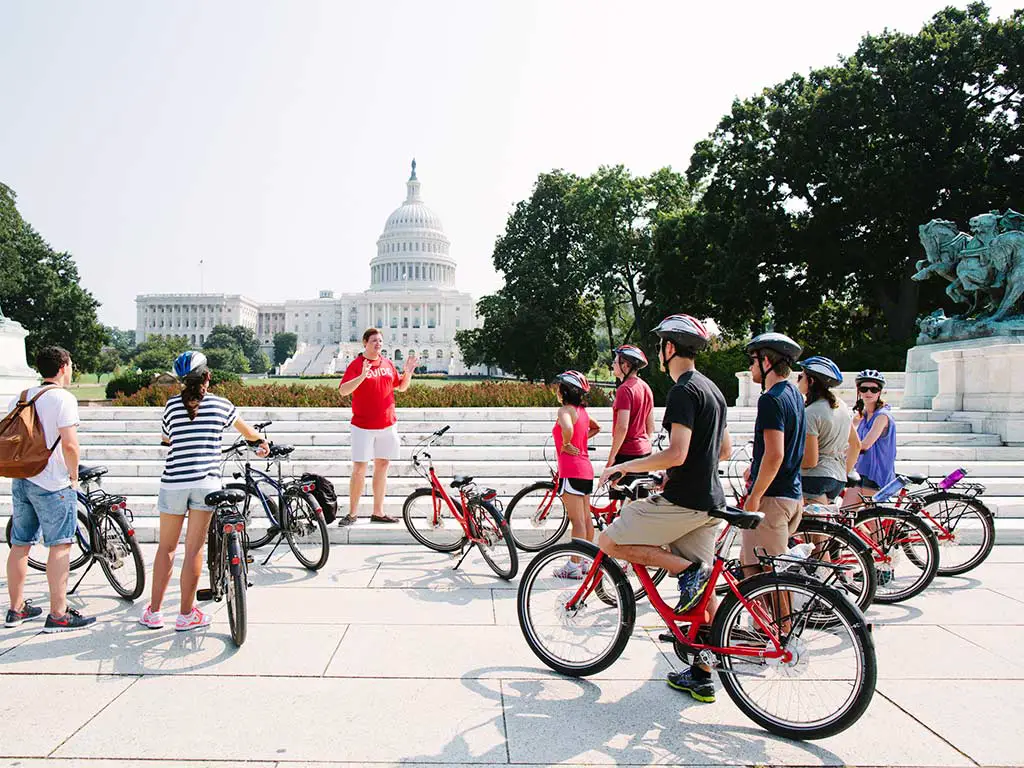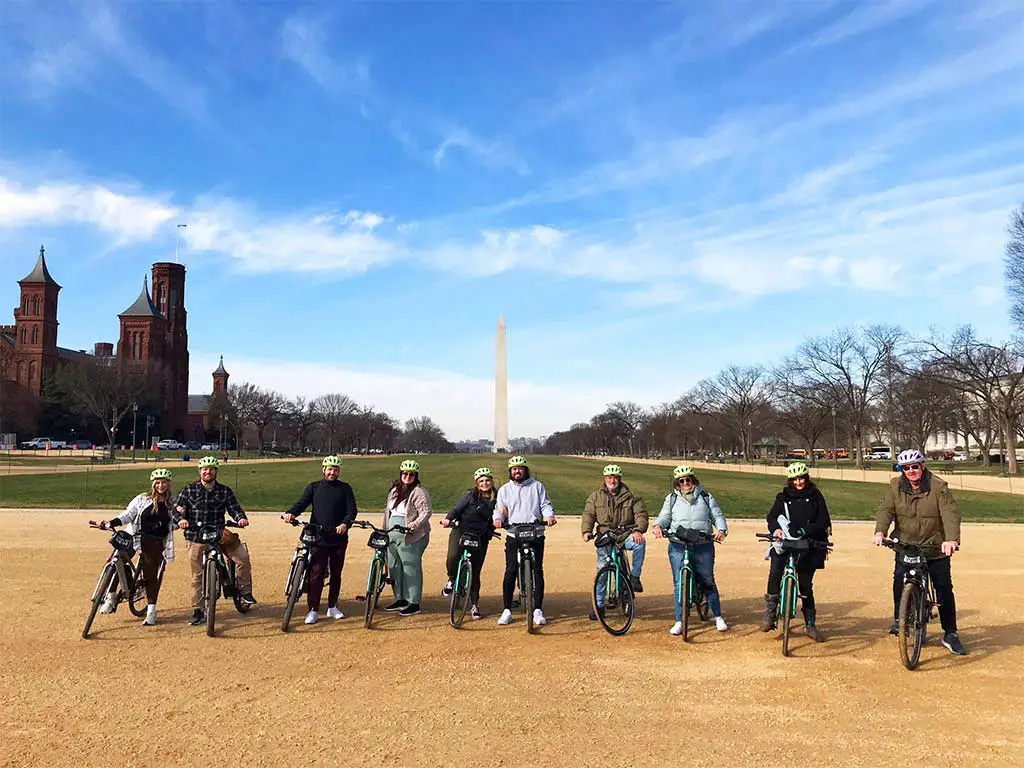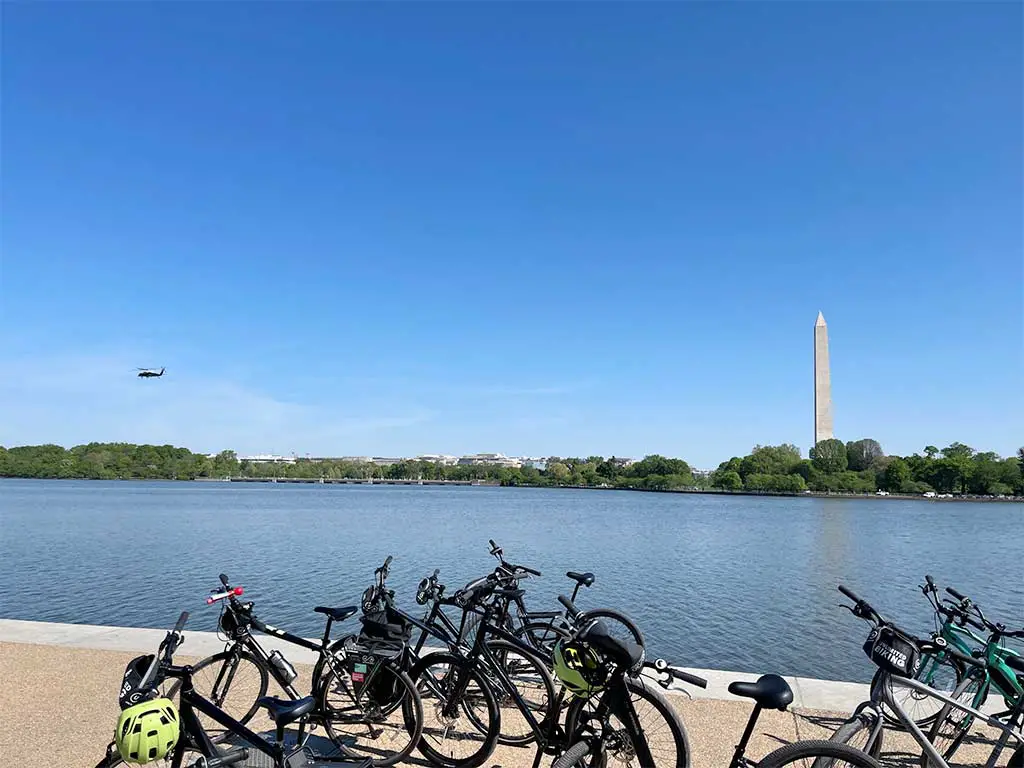Looking for an exciting and unique way to explore Washington DC’s iconic landmarks? A bike tour of Washington DC’s monuments is the perfect solution.
This engaging adventure allows you to experience the city’s rich history and stunning architecture up close.
Pedaling through the National Mall, you’ll visit key sites like the Lincoln Memorial, Washington Monument, and Jefferson Memorial, all while enjoying the fresh air and scenic views.
With well-maintained bike paths and knowledgeable guides providing historical context, you can discover the capital’s treasures in an active, eco-friendly manner.
Whether you’re a solo traveler, a family, or a group of friends, a bike tour offers a memorable and immersive way to see the best of Washington DC. So, stay focused.
What Is Washington DC Monuments Bike Tour?
The Washington DC Monuments Bike Tour is a guided cycling excursion through the nation’s capital, offering an immersive way to explore its iconic landmarks.
Participants typically ride through the National Mall, visiting major monuments such as the Lincoln Memorial, Jefferson Memorial, Washington Monument, and the Martin Luther King Jr. Memorial.
The tour often includes stops at the Vietnam Veterans Memorial and the World War II Memorial.
Led by knowledgeable guides, the tour provides historical context and interesting anecdotes about each site. It’s designed for all skill levels, with routes that are safe and manageable, often including bike-friendly paths and leisurely paces.
Tours generally last between two to three hours and cover around four to eight miles. They can be enjoyed during the day or at night, offering different perspectives of the monuments.
This eco-friendly and engaging tour is an excellent way for visitors to experience Washington DC’s rich history and stunning architecture in an active and enjoyable manner.
Bike Routes of Washington DC Monuments

Exploring Washington DC’s monuments by bike offers a unique and engaging way to experience the city’s iconic landmarks, providing scenic routes, historical insights, and an eco-friendly adventure through the heart of the nation’s capital.
Iconic Routes
The bike routes of Washington DC’s monuments offer cyclists a scenic and historical journey through the heart of the nation’s capital. These routes are meticulously planned to ensure a safe, enjoyable, and informative experience.
National Mall Loop
The National Mall Loop is a favorite among visitors, encompassing major landmarks like the Lincoln Memorial, the Washington Monument, and the U.S. Capitol.
This loop is relatively flat and bike-friendly, making it suitable for all skill levels. The well-paved paths and clear signage ensure an easy navigation through this iconic stretch.
Tidal Basin Route
Cyclists can enjoy the Tidal Basin Route, which offers breathtaking views of the Jefferson Memorial, Franklin D. Roosevelt Memorial, and the Martin Luther King Jr. Memorial.
This route is especially beautiful during the cherry blossom season in spring. The path around the Tidal Basin is well-maintained, providing a serene and picturesque ride.
Potomac River Trail
The Potomac River Trail is a longer route that extends beyond the central monuments, following the river to sites such as the Kennedy Center and the Theodore Roosevelt Island.
This trail combines urban biking with natural scenery, offering a diverse riding experience. It’s ideal for those looking to extend their tour and explore less crowded areas.
Night Tours
For a unique experience, many tours offer night rides. The Night Monuments Tour illuminates the landmarks under the evening sky, providing a different perspective of the city.
Landmarks like the Washington Monument and the Lincoln Memorial are beautifully lit, creating a stunning visual experience.
Memorials and Museums Path
This path includes a comprehensive tour of the war memorials, including the Vietnam Veterans Memorial, Korean War Veterans Memorial, and World War II Memorial.
Additionally, cyclists can pass by the numerous Smithsonian museums, making it a culturally enriching route. This path is perfect for those who want to delve deep into the historical and cultural fabric of the capital.
Eco-Friendly and Accessible
Cycling in Washington DC is not only an eco-friendly way to tour the city but also highly accessible. The city’s bike-share programs, such as Capital Bikeshare, offer convenient rental options.
Dedicated bike lanes and trails ensure a safe and pleasant journey. With ample bike racks and rest spots, cyclists can easily stop to admire the sights or take a break.
Guided vs. Self-Guided Tours
Riders can choose between guided tours, which provide historical insights and structured routes, or self-guided tours for a more flexible pace.
Guided tours often include knowledgeable guides who share interesting facts and stories about each monument, enhancing the educational experience.
Exploring Washington DC’s monuments by bike offers a unique, engaging, and healthy way to experience the rich history and beauty of the nation’s capital.
Best Time to Visit Washington DC Monuments Bike Tour

Visiting Washington DC’s monuments by bike is a fantastic way to experience the city, but timing your visit can significantly enhance your experience.
The best time to embark on a Washington DC Monuments Bike Tour depends on several factors, including weather, crowd levels, and special events.
Spring: Cherry Blossom Season
Spring, particularly late March to early April, is one of the best times to visit due to the National Cherry Blossom Festival. The city is adorned with blooming cherry trees, especially around the Tidal Basin.
This season offers mild temperatures and picturesque scenery, making it an ideal time for a bike tour. However, it’s also a popular tourist season, so expect larger crowds.
Summer: Long Days and Vibrant Atmosphere
Summer, from June to August, offers long daylight hours and a vibrant atmosphere with numerous festivals and events.
Early mornings or late afternoons are the best times to avoid the midday heat and crowds. Hydration and sun protection are crucial during this period.
Despite the heat, summer’s lively vibe and extended daylight make it a great time for an evening bike tour to see the illuminated monuments.
Fall: Mild Weather and Fewer Crowds
Fall, from September to November, is another excellent time for a bike tour. The weather is generally mild, with cooler temperatures and less humidity.
The fall foliage adds a beautiful backdrop to the monuments, and the crowds are thinner compared to the peak spring and summer seasons. This season offers a more relaxed and enjoyable biking experience.
Winter: Quiet and Peaceful Tours
Winter, from December to February, is the quietest time for a bike tour. Although temperatures are colder, the lack of crowds provides a peaceful and serene atmosphere.
Proper winter clothing and gear can make the experience enjoyable. Additionally, the holiday decorations in December add a festive charm to the monuments.
Weekdays vs. Weekends
Weekdays are typically less crowded than weekends, offering a more relaxed experience.
If possible, plan your bike tour for a weekday to avoid the weekend rush. Early mornings on weekdays are particularly serene and offer the best opportunity to enjoy the monuments without the crowds.
Special Events and Holidays
Consider special events and holidays when planning your visit. Major events like the Fourth of July and Memorial Day can bring large crowds but also offer unique experiences and festivities.
Conversely, visiting right after these events can provide a quieter and more enjoyable tour.
Some Night Tours
Regardless of the season, night tours offer a unique perspective. The monuments are beautifully illuminated, and the city is quieter, providing a serene and majestic experience.
Night tours are especially pleasant in the summer when the temperatures are cooler after sunset.
Choosing the best time for a Washington DC Monuments Bike Tour depends on your preferences for weather, crowd levels, and special events. Each season offers a unique experience, ensuring a memorable visit to the nation’s capital.
Tips to Successfully Enjoy Washington DC Monuments Bike Tour

Embarking on a Washington DC Monuments Bike Tour is an exciting way to explore the capital’s historic landmarks.
To ensure you have a smooth and enjoyable experience, consider these essential tips for planning and executing your bike tour.
1. Choose the Right Time
Selecting the right time for your tour is crucial. Aim for early mornings or late afternoons to avoid peak tourist hours and the midday heat, especially in summer.
Spring and fall offer the most pleasant weather, with fewer crowds compared to peak tourist seasons.
2. Dress Appropriately
Wear comfortable, weather-appropriate clothing. In summer, opt for lightweight, breathable fabrics, and don’t forget your sunglasses and sunscreen.
In cooler months, layer your clothing to stay warm. A light rain jacket can be handy for unexpected showers.
3. Stay Hydrated and Bring Snacks
Cycling can be physically demanding, so staying hydrated is essential. Bring a reusable water bottle and refill it at water fountains available around the city.
Pack light snacks like energy bars or fruit to keep your energy levels up during the tour.
4. Use a Comfortable and Reliable Bike
Ensure your bike is comfortable and well-maintained. If you don’t have your own, consider renting from reputable bike rental services like Capital Bikeshare.
Check the brakes, gears, and tires before starting your tour. Many guided tours provide high-quality bikes and helmets.
5. Plan Your Route
Familiarize yourself with the route in advance. Map out key monuments and points of interest, including the Lincoln Memorial, Washington Monument, and Jefferson Memorial.
Utilize bike-friendly paths and designated lanes to ensure a safe ride. Guided tours often have pre-planned routes that cover major landmarks efficiently.
6. Follow Safety Guidelines
Safety should always be a priority. Wear a helmet, obey traffic signals, and use hand signals when turning. Stay in designated bike lanes where possible and be aware of pedestrians and other cyclists.
If you’re unfamiliar with the area, joining a guided tour can enhance safety and provide valuable insights.
7. Take Breaks and Enjoy the Scenery
Don’t rush through the tour. Take time to stop at each monument, read the informational plaques, and enjoy the scenery.
Photograph the landmarks and soak in the historical significance of each site. Scheduled breaks also allow you to rest and refresh.
8. Utilize Guided Tours for Enhanced Experience
Consider joining a guided bike tour for a more informative experience. Knowledgeable guides share fascinating historical facts and stories about each monument, enriching your understanding and appreciation of the sites.
Guided tours also handle the logistics, making your trip more relaxed and enjoyable.
Successfully enjoying a Washington DC Monuments Bike Tour involves careful planning, appropriate preparation, and prioritizing safety.
By choosing the right time, dressing appropriately, staying hydrated, and following safety guidelines, you can ensure a memorable and enriching biking experience through the historic heart of the nation’s capital.
Wrapping Up
A bike tour of Washington DC’s monuments offers an unparalleled way to experience the city’s historic landmarks and scenic beauty.
Whether you choose to visit during the vibrant spring, the lively summer, the colorful fall, or the peaceful winter, each season provides a unique and memorable experience.
By dressing appropriately, staying hydrated, planning your route, and following safety guidelines, you can ensure a smooth and enjoyable tour.
Additionally, considering a guided tour can enhance your experience with historical insights and hassle-free logistics.
Ultimately, a bike tour through Washington DC allows you to engage with the city’s rich history and stunning architecture in an active, eco-friendly manner. Best of luck.




Scott Jung